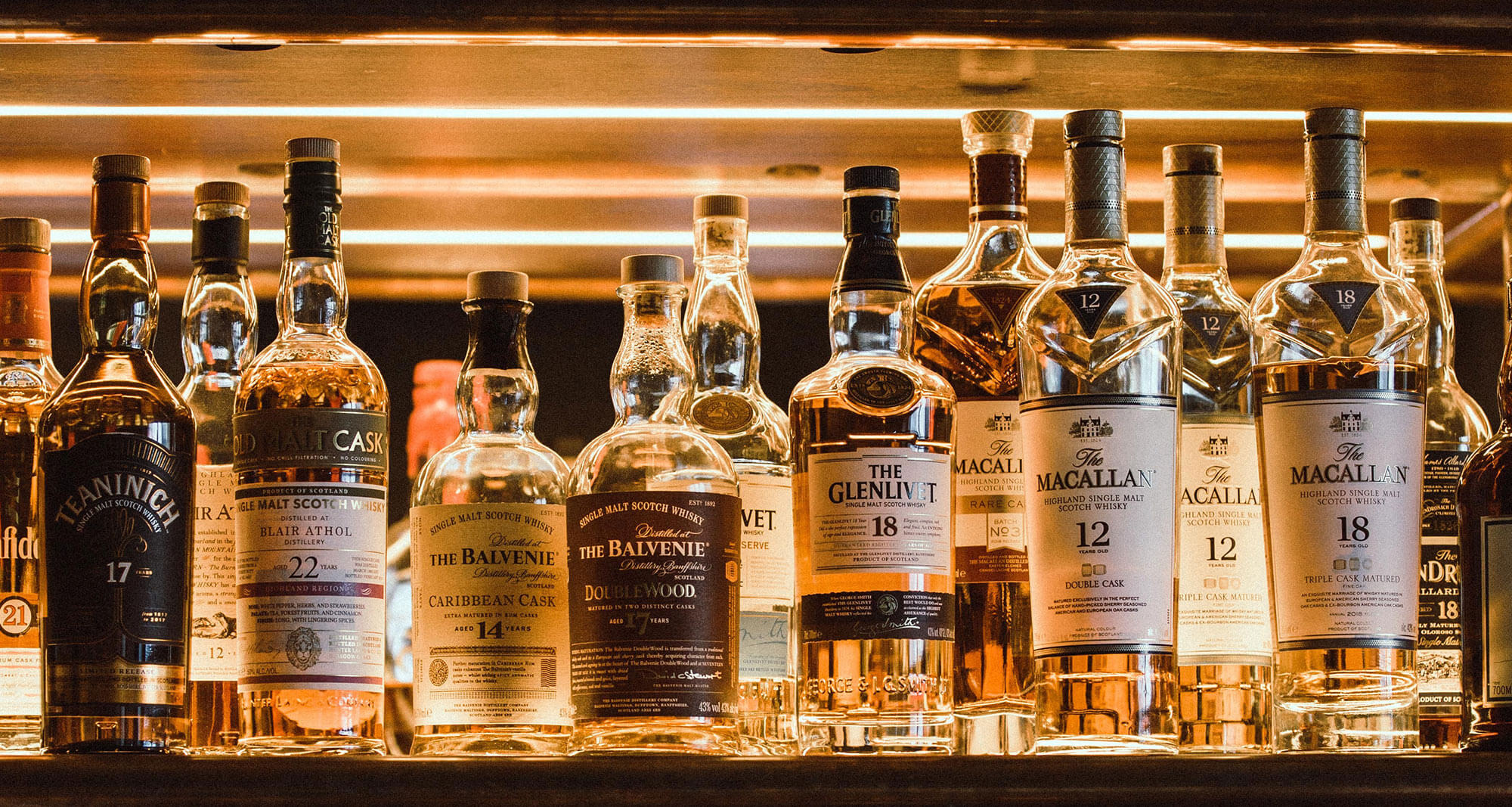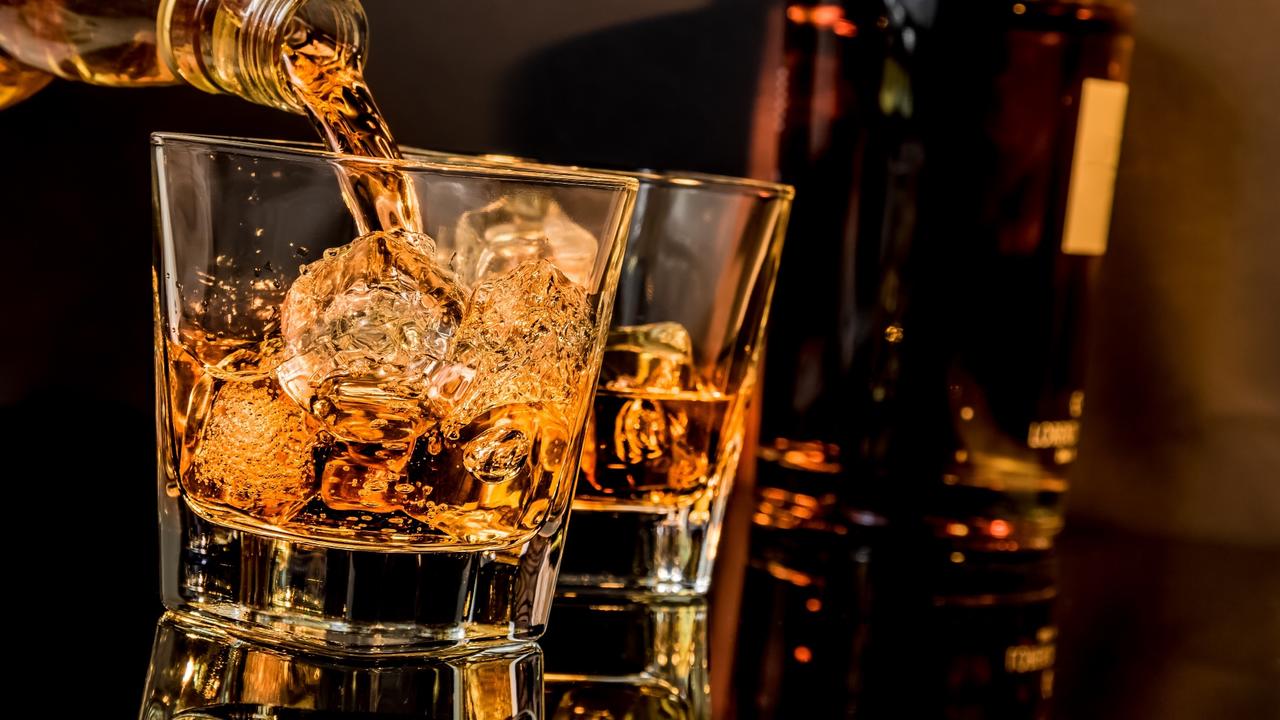Ever wished you could find all your whiskey-related questions in one place? Look no further! From distillation to spelling, you will find it all here...
What is whiskey?
Whiskey is a golden-coloured spirit made from three simple ingredients: cereal grain, water and yeast. The common grain used is malted barley, but not all whiskies use barley as their base grain. Scotch whisky and Japanese whisky both use malted barley as their main grain. Bourbon whiskey, however, uses corn as its main grain, whilst rye whiskey uses rye, unsurprisingly.
How is whiskey made?
Whiskey production really depends on the country and type of whiskey. Every distiller and grain have a slightly different process, but the fundamentals remain the same. There are six steps to making whiskey...

1. Malting
This is the first process of turning the starch of the cereal grains into sugars. Barley grains are mixed with water to completely soak. Barley cereal must go through a slightly longer process to partially germinate before, however. Malting is a process quite unique to barley.
This all starts as a grain! Find out what is whisky made from.
2. Drying
Once soaked, the grain is dried in a kiln oven to stop germination, before being ground down into a flour called 'grist'. For barley, this process turns the unmalted barley into malted barley. Peat can be used in the ovens for the drying process, which is why some Scotch whiskies often have a peaty flavour. Our whisky expert Ludo Ducrocq explains all about the process of peated whisky production.
3. Mashing
Before the fermentation, all the sugars must be extracted. The grain has now been cleaned and ground down to form a flour. This is mixed in a large tank of hot water called a 'mash tun'. The mash tun is stirred vigorously for hours to fully convert the starch into sugars. These sugars are called 'maltose'. The maltose dissolves into the flour, leaving a liquid residue. This residue looks a lot like porridge, which is called the 'wort'.
The water used during mashing is key. Water can affect the final product in taste and appearance, so using fresh or spring water is a must.
4. Fermentation
The wort is then cooled to be mixed with yeast in large tanks called 'wash backs' to make a fermented mash of grain. The yeast converts the maltose into alcohol. After a few days, this liquid is called the 'wash' and has an alcohol percentage of roughly 8-9%.
5. Distillation
This is the tricky part. Whiskey must be distilled using two huge kettles (wash stills). The first kettle warms up the wash to isolate the alcohol. Alcohol has a lower boiling point than water, so once it evaporates it is cooled. Then, the liquid condensates and is collected. This liquid is called 'low wines' and contains 20% alcohol. This is transferred to the second kettle to be distilled once more. Now, the liquid is 'high wines' and is separated into three parts, but only the 'middle cut' is used to make whiskey in the maturation stage. This twice-distilled middle cut contains roughly 65% alcohol.
Whilst this is the general process of distilling whiskey, each type or country has subtle distilling differences. For instance, Tennessee whiskey filters the high wines through sugar maple charcoal. Scotch whisky uses traditional copper kettles during distillation. It's each one of the small differences that can significantly differentiate each type of whiskey and their taste.
6. Maturation
Finally! This is the last bit, where the whiskies develop their flavour and appearance. The middle cut is cooled and poured into wooden barrels. Whiskey must be aged for at least three years to be classified as whiskey. These wooden casks not only develop the flavour but also turn the whiskey brown. For American whiskey, it's the charred oak barrel that gives whiskey its iconic mahogany colour.
Just like with distilling whiskey, the maturation period can vary from whiskey to whisky. For example, American whiskies are aged in warm, dry conditions, whereas Scotch is aged in cool, wet conditions.
Learn more about the making whisky with oak and whisky maturation here.

What is the 'Angel's Share'?
This is a process during maturation. As the whiskey matures in the casks it loses approximately 2% of liquid content per year, due to evaporation. This, ultimately, limits the amount of time whiskey can mature for. Early distillers noticed the missing portion and said it was for the angels, hence 'Angel's Share'.

The history of whiskey
The history of whiskey is a turbulent one. Here we'll give you a short overview of its long existence…
- Circa 1200 AD - The idea of distilled spirits has been around for a long time but has only now reached Scotland and Ireland by travelling monks. The harsh weather conditions made the British Isles no place for grape production and so instead they used grain.
- 1494 - This is the first piece of written evidence of whiskey. A Scottish friar was sent malt to make 'aqua vitae', or as we say, 'whiskey'.
- 1600s - As Europeans colonised America, they brought with them the art of whiskey making. They began to distil new grains making new types of whiskey, like corn whiskey.
- 1608 - The opening of Old Bushmills Distillery in Northern Ireland. This distillery still produces whiskey today and holds the title of the oldest whiskey distillery in the world.
- 1791 - The Revolutionary War forced the American government to tax domestically distilled spirits, in which the majority was whiskey. This was later dubbed the 'Whiskey Tax' leading to the 'Whiskey Rebellion' by farmers.
- 1823 - Great Britain legalises whiskey production.
- 1920-1933 - The years of Prohibition. The United States banned the production, sale and use of alcohol. However, this excluded 'medicinal whiskey' which could be prescribed and sold through licensed pharmacies.
What are the differences between whiskey, Scotch and Bourbon?
Between Scotch and Bourbon, the differences lie within production and 'mash bill' (grain contents). 'Whiskey' is just the term that encompasses all types of whiskey and is not a specific type. The lists below go through their main differences, as well as common whiskey styles!
- Scotch - This whisky can only be produced in Scotland. It is made mainly from barley but can sometimes be a mixed grain blend. It must be aged in oak barrels for a minimum of three years.
- Bourbon - Bourbon is an American whiskey and only made in the USA. Must have corn as at least 51% of the grain content and is aged in charred new oak casks.
- Tennessee - Those from Tennessee like to emphasise their differences from American bourbon! Tennessee whiskey does use a similar process and mash bill to Bourbon, but instead uses a process of charcoal filtering called the 'Lincoln County Process'.
- Irish - Irish whiskey can be made from a mixed grain or malted grain. It is aged in wooden casks.
- Rye - This whiskey can be produced anywhere but must have at least 51% rye in the mash bill. It's matured in charred wood barrels.
- Canadian - Canadian whisky mixes both corn and rye.
- Japanese - This new, up and coming whisky uses a similar production process to Scotch. It uses double malted or peated barley as its choice of cereal.
Want to know more about Scotch whisky? Check out our what is Scotch page here.
What does 'single malt' and 'blended malt' mean?
Single malt - Single malts are made of 100% malt from one single distillery.
Blended malt - 100% malt but using two malt whiskies from multiple distilleries.
Blended - A combination of malt and grain.
Cask strength - Whiskey bottled directly from the barrel, undiluted.
Single cask - Whiskey poured from only one cask.

What does whiskey taste like?
There are so many types of whiskey out there that it's impossible to sum it up in one sentence, unfortunately. The production process, grain and even water all affect the taste. However, once again, we've made a list to give you a good overview of whiskey's taste to turn you into a whiskey tasting expert!
It's important to note that the different styles of whiskey can make a difference! A single malt Scotch will taste a little different to a blended whiskey, so keep this in mind when you're buying.
- Scotch - Smoky, tobacco, peat, vanilla.
- American Whiskies - Honey, oak, caramel, slightly smoky.
- Irish Whiskey - Fruity, marmalade, vanilla. A lighter flavour.
- Rye Whiskey - Oak, spices, smoky.
- Canadian Whisky - Oak, smoky, vanilla.
- Japanese Whisky - Honey, wood, perfume.
Want to know what food goes with whiskey? Talking all things steaks and snacks, this comprehensive guide answers all your questions!

How to drink whiskey
The 'whiskey purists' will tell you drinking whiskey neat is the only way. Ice and mixers are strictly forbidden! This is how you can get the full experience of your chosen whiskey. However, it's all personal taste.
Read over our whisky expert tips on how to drink whisky properly, written by whisky expert Ludo Ducrocq.

Popular whiskey brands
- Scotch Whisky- Johnnie Walker, Glenfiddich, Ballantine's.
- Bourbon Whiskey- Four Roses, Knob Creek, Maker's Mark.
- Tennessee Whiskey - Jack Daniel's, Prichard's, George Dickel.
- Irish Whiskey - Jameson, Tullamore Dew, Bushmills. Although, the Emerald Isle is well known for many other great Irish whiskey brands too.
- Rye Whiskey - Bulleit Rye, Knob Creek, Basil Hayden.
- Canadian Whisky - Forty Creek, Canadian Club, JP Wiser's.
- Japanese Whisky - Hibiki, Nikka, Yamazaki 25.

7 Popular whiskey cocktails
- Mint Julep - Bourbon, mint, sugar, water.
- Whiskey Sour - Bourbon, egg white, lemon juice, simple syrup.
- Godfather - Scotch, amaretto.
- Old Fashioned - Bourbon, Angostura bitters, sugar, water.
- Rusty Nail - Scotch, Drambuie.
- Manhattan - Rye whiskey, sweet red vermouth, Angostura bitters.
- Sazerac - Rye whiskey, absinthe, Peychaud's bitters, sugar cube.
Read more about cocktails with this post on 5 simple whiskey cocktail recipes.
What are whiskey stones?
Whiskey stones, also known as 'whiskey rocks', are a reusable and refined alternative to ice cubes. Just leave them in the freezer to freeze and add them to your drink for a cold but undiluted glass of whiskey.
Whiskey FAQs

Does whiskey go off?
Yes, whiskey goes bad after one or two years after opening. Unopened whiskey has an indefinite shelf life until opened.
Is it 'whiskey' or 'whisky'?
The answer is both! You can write both 'whiskey' and 'whisky'.
The word's origin comes from Gaelic as 'usquebaugh', meaning 'water of life'. The spelling difference has come from the translation between Scottish and Irish Gaelic. In the 1800s, it's believed that the Irish tried to differentiate themselves from the low-quality Scottish whisky through the subtle spelling difference. As many Irish settled in America, the Americans eventually adopted this spelling, it's believed.
Although, it must be said that when talking about specific whiskey types, spelling is important. For whiskies from Scotland, Canada and Japan it's WHISKY. For whiskies made in Ireland and America it's WHISKEY.
Does whiskey continue to mature in the bottle?
No, whiskey only matures in the barrel. Once a whisky is bottled, its characteristics do not change.
What's the nutritional value of whiskey?
So, what is whiskey made from? The good news for non-meat eaters out there, is that whiskey is both vegetarian and vegan. It's entirely made of plant-based ingredients, so enjoy it alongside your favourite veggie burger! It must be said, however, that vegans should avoid whiskey cream liqueurs.
Whiskey is also gluten-free. Despite containing gluten-rich grains, like barley or rye, due to the distillation and purification process, whiskey becomes gluten-free. For those on a diet, whiskey is also a friend of yours.
Per 35ml serving, it contains:
| Calories | 78 |
| Carbohydrates | 0g |
| Fat | 0g |
| Sugar | 0g |
Should I drink whiskey with ice?
Whilst it will dilute the whiskey somewhat, it can turn the taste into something more subtle and drinkable. This is also the case when adding a little water to whiskey. It reduces the ABV percentage and opens the flavours. Experts actually recommend adding a few drops to appreciate the character more!
How do I become a whiskey expert?
Every whiskey expert starts in a different way, but tours of distilleries are a great place to learn the whiskey basics. You’ll get first-hand experience of the process and get taken through all the stages of production, from malting to maturation. See our EBS whiskey expedition for more details.
Alternatively, look out for local whisky tasting nights and grab your chance to talk to an expert. In the meantime, learn how to taste whiskey like an expert.
How much does whiskey cost?
We already have an extensive guide to whisky prices but in short, the answer varies. Many of the popular whiskey brands we mentioned are generally affordable, ranging between £20-£70 in cost. Remember that good whiskies don't have to be expensive!
Can I make whiskey at home?
Sorry to end on a bad note, but no - we don’t recommend this at all. Not only is it illegal in most countries, without specialist equipment and controls, you also won’t be sure of how strong your whiskey is and if it's safe to drink.
What's the strangest whiskey story?
We think that the “Old Canadian Toe” tale is by far the strangest whiskey story. In 1973, a Canadian police captain called Dick Stevenson discovered the preserved big toe of a local miner called Louie Liken from 1920, while cleaning out a cabin.
The captain (perhaps on seeing the toe floating in alcohol) thought it would be a good addition to a local whiskey bar called the Sourdough Saloon.
Supposedly with little else to do in town, the locals challenged each other to down their whiskies, with old Liken's toe floating at the bottom.
Since then, even though the toe has been swallowed, stolen and replaced many times, the Sourtoe club has been going strong. Today, those who are able to drink the whiskey and touch the toe to their lips, win a certificate to show their achievement.
And that's it! We hope you have answered all your questions on what is whiskey.
Read up on whiskey sales globally in this piece written by our resident whisky expert. Or explore the differences between liquor vs liqueur and find out what really separates them!
Feeling inspired to master whiskey behind the bar professionally? Look into our bartending course and how it can help you reach your goal in becoming a professional bartender...

